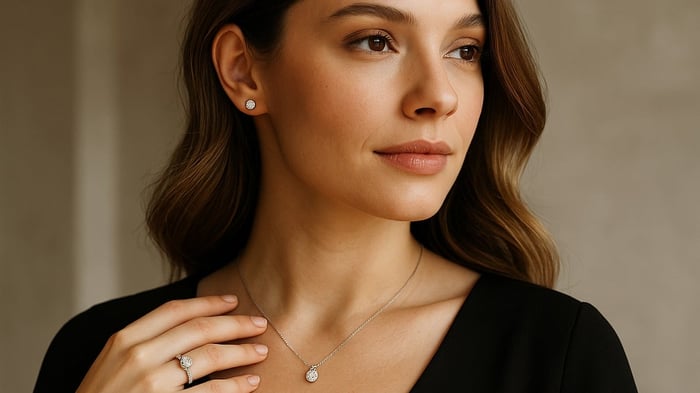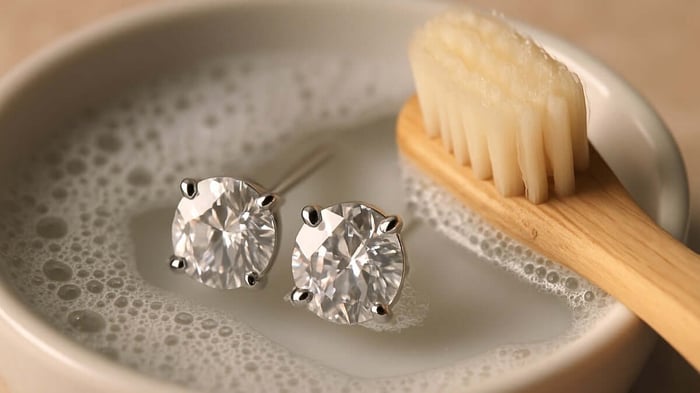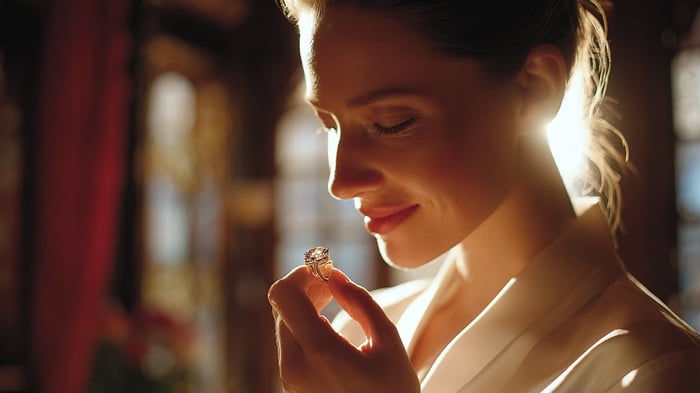Table of Contents
The diamond world is changing fast. Lab-grown diamonds have brought dazzling brilliance to a new audience, offering real carbon crystals at lower prices and with modern appeal. Yet for all their innovations, there remains a simple truth: fine jewellery, made with natural diamonds, has always been defined not only by beauty but also by meaning, permanence, and provenance.
Natural diamonds embody those qualities. They are the original miracle of time and pressure — rare, ancient, and unique. When we celebrate life’s most significant moments, it’s those qualities we instinctively seek.
This discussion isn’t a debate about chemistry or even about price. It's about what fine jewellery represents.
The Rarity Principle
Every natural diamond is a geological wonder. Born more than a billion years ago under immense pressure deep within the Earth, each one is the result of an unrepeatable natural process. That natural origin — the slow choreography of carbon, heat, and time — is what gives a diamond its status as something precious.
In contrast, a lab-grown diamond is produced in just a few weeks; while the technology is remarkable, it substitutes nature’s mystery with engineering precision. The result may be identical in structure and appearance, but not in meaning.
Rarity matters because it shapes value — emotional as much as financial. Just as a painting’s worth lies not only in its image but in its origin, a diamond’s beauty gains depth from the story of its creation. As the Gemological Institute of America (GIA) notes, “The natural diamond is a product of the earth… each one is a fragment of deep time.”¹
A natural diamond therefore carries with it something intangible but unmistakable: the sense of awe that comes from knowing it has taken the Earth more than a billion years to make what we now hold in our hand.
Aretes de Diamantes 0.10ct Calidad G/SI en Oro Blanco 18k

€423,95
Este brillante par de aretes de diamantes tiene diamantes de calidad G/SI sostenidos de manera segura por reluciente oro blanco de 18 qt. Estos elegantes aretes serían una excelente inversión ya que el diseño clásico asegura que nunca pasarán de… read more
Authenticity and Emotional Significance
Jewellery, at its best, isn’t just decoration. It’s storytelling — of love, milestones, and legacy. A natural diamond engagement ring or anniversary pendant doesn’t just sparkle; it speaks to endurance, permanence, and commitment.
When a diamond has formed over aeons, it naturally feels worthy of marking the rarest moments in our lives. It connects us symbolically to the deep past and the future, to something greater and more lasting than ourselves.
That’s why natural diamonds become heirlooms. They’re the pieces we pass down, imbued with family stories and emotions that can’t be replicated in a lab. As Vogue once observed, “The allure of a diamond isn’t simply its brilliance—it’s the sense that it has witnessed time.”²
A lab-grown diamond, however beautiful, doesn’t yet carry that cultural weight. It’s a triumph of technology, not of nature. And while it can represent a moment, it rarely becomes a legacy.
The True Cost of Fine Jewellery
There’s a common assumption that lab-grown diamonds are dramatically cheaper than natural ones, and it is largely true. But when you examine the full cost of fine jewellery—design, craftsmanship, precious metals, settings, finishing, and retail—the difference is far smaller than most people imagine.
In one example, a pair of modern diamond stud earrings in 9K white gold costs £227 with natural diamonds and £135 with lab-grown stones of identical size and similar setting. The saving is real, but in the context of a lifetime piece of jewellery, it’s modest — and it comes with a trade-off in meaning and lasting value.
That’s because the gemstone is only one part of what you’re buying. Fine jewellery involves skilled hands, intricate polishing, and metalwork that is designed to endure for decades. Whether the stone was mined or manufactured, those human and material costs remain the same.
The choice becomes less about price and more about character when the overall craftsmanship is valued equally. What are you really buying, a passing fashion statement or a piece to carry through life?
Pendientes Paperclip de Diamantes 0.80ct Calidad G/SI en Oro Amarillo 9k

€1.081,95
Agregar descripción… read more
Value and Investment
Fine jewellery is more than adornment; it’s a form of wealth preservation in miniature. Natural diamonds have held a recognisable market value for over a century, supported by stable grading systems and long-term demand. Their rarity and finite supply underpin that resilience.
Lab-grown diamonds, by contrast, are produced in expanding quantities at falling costs. That means their resale value drops sharply over time, a reality quietly acknowledged by the very retailers who sell them. Forbes recently reported that second-hand lab-grown diamonds “may have little to no resale value,” while natural diamonds remain “anchored by intrinsic scarcity and consumer trust.”³
Of course, most people don’t buy jewellery with the intention of selling it. But knowing that a piece retains worth adds to its sense of permanence and importance. A natural diamond engagement ring isn’t just a symbol of love — it’s a small, beautiful form of enduring value.
Ethics, Transparency, and the Environment
For years, lab-grown diamonds were marketed as the ethical alternative. But the picture is more complex than early advertising suggested.
Today, the natural diamond industry has undergone a remarkable transformation. Modern mining operations are highly regulated and transparent, supporting entire national economies and local communities. In Botswana, for instance, diamond revenues have funded schools, hospitals, and infrastructure, a model of shared prosperity often cited by the United Nations Development Programme.
Meanwhile, lab-grown production, particularly in countries using coal-fired energy, can have a surprisingly heavy carbon footprint. A 2023 report by S&P Global found that diamonds grown using Chemical Vapour Deposition (CVD) methods in regions dependent on fossil fuels can generate three times more carbon emissions than responsibly mined natural diamonds.⁴
The ethical conversation has matured: it’s no longer a simple case of “good” versus “bad”, but of transparency, accountability, and long-term sustainability. Both sectors are improving, but only one creates lasting economic value for the communities that depend on it.
Anillo de compromiso y boda con diamantes a juego certificados 0,70 ct G/SI Oro blanco de 18 k

€1.854,95
La pura calidad del trabajo de nuestros artesanos del Reino Unido brilla a través de este conjunto de boda y anillo de compromiso a juego, elaborado en hermoso oro blanco de 18 quilates y diamantes atemporales de origen ético. Un… read more
The Meaning of Fine Jewellery
Perhaps the most important distinction isn’t geological or economic, but emotional.
Fine jewellery marks the moments that define a life: engagements, anniversaries, births, and achievements. It’s not bought for a season or a trend. It’s chosen because it expresses something profound and enduring.
Lab-grown diamonds have their place; they’re wonderful for fashion jewellery, travel pieces, or gifts that celebrate personal style. They’re bright, accessible, and allow for larger stones at approachable prices.
But when it comes to the symbols we carry through life, the ring that represents love, the pendant that becomes an heirloom, the earrings that one day will belong to a daughter or granddaughter, most of us instinctively reach for nature’s originals.
That instinct isn’t about status. It’s about authenticity. We want the real thing because the moments we mark are real.
What Endures Will Last Forever
A natural diamond is more than a stone; it’s a piece of the Earth’s history made wearable. Its rarity gives it value. Its permanence gives it meaning. Its beauty connects generations.
Technology can reproduce brilliance — but not origin, story, or soul.
When we choose natural diamonds, we choose continuity over convenience, substance over simulation, and truth over trend. In a world that moves ever faster, there’s something quietly powerful about wearing a gem that took a billion years to form—and that will last forever.
Brazalete Tennis de Diamantes 3.00ct G/SI en Oro Blanco 18k

€3.942,95
Ponte esta pulsera de diamantes para añadir un poco de brillo a tu look. El diseño delicado y elegante es una manera perfecta de agregar un toque de estilo a los atuendos casuales. El tamaño diminuto hace que sea fácil… read more
Discover the Beauty That Lasts
A natural diamond doesn’t just sparkle — it speaks. It captures the quiet moments, the milestones, and the memories that define a life. When you choose natural, you’re choosing more than brilliance; you’re choosing a story that endures.
Discover our collection of natural diamond jewellery, crafted in precious metals and designed to be worn, loved, and passed on. True beauty evokes memories beyond mere sight.
Your Real, Natural Diamond Jewellery Is Here!
References
GIA – Diamond Origin / Formation
“Diamonds formed 90 million to 3 billion years ago …” — Gemological Institute of America
https://discover.gia.edu/diamond-origin.html discover.gia.eduGIA – Diamond Description / How Diamonds Form
“Diamond forms under high temperature and pressure conditions …” — GIA
https://www.gia.edu/diamond-description GIAForbes – Lab-Grown Diamonds: Resale Value Warning
“The inconvenient truth … LGDs embody virtually zero resale value as compared to natural diamonds.” — Forbes
https://www.forbes.com/sites/kyleroderick/2019/08/24/lab-grown-diamonds--regulators-warn-that-some-claims-fail-to-fulfill-their-hype/ ForbesS&P Global / DPA Report – Lab-Grown vs Natural Emissions
“Emissions associated with lab grown diamond production are approximately 3 times …” — S&P / DPA
https://www.spglobal.com/content/dam/spglobal/mi/en/documents/general/The-Socioeconomic-and-Environmental-Impact-of-Large-Scale-Diamond-Mining_DPA_02-May-2019.pdf S&P GlobalThe Jewellery Editor – Carbon Footprint Report
“160 kgs CO₂ per polished carat of mined diamonds vs 511 kgs for lab-grown diamond” — The Jewellery Editor
https://www.thejewelleryeditor.com/jewellery/article/report-reveals-lab-grown-diamonds-high-carbon-footprint-eco-diamonds/ thejewelleryeditor.comForbes – Are Lab-Grown Diamonds Real / Resale Issues
“According to Nolan, they tend to have lower resale value.” — Forbes
https://www.forbes.com/sites/forbes-personal-shopper/article/are-lab-grown-diamonds-real/ ForbesGIA – How Do Diamonds Form in the Deep Earth
A more technical take on diamond formation in mantle, fluid processes, etc.
https://www.gia.edu/gems-gemology/winter-2018-how-do-diamonds-form-in-the-deep-earth GIA




